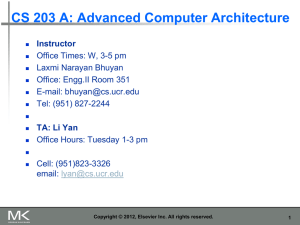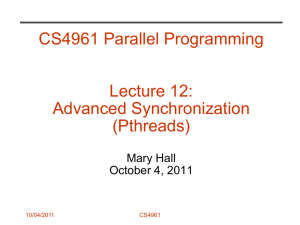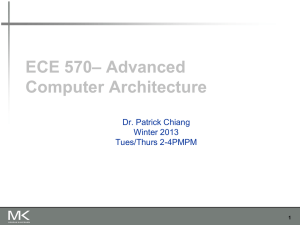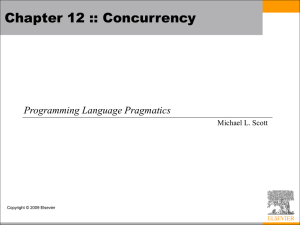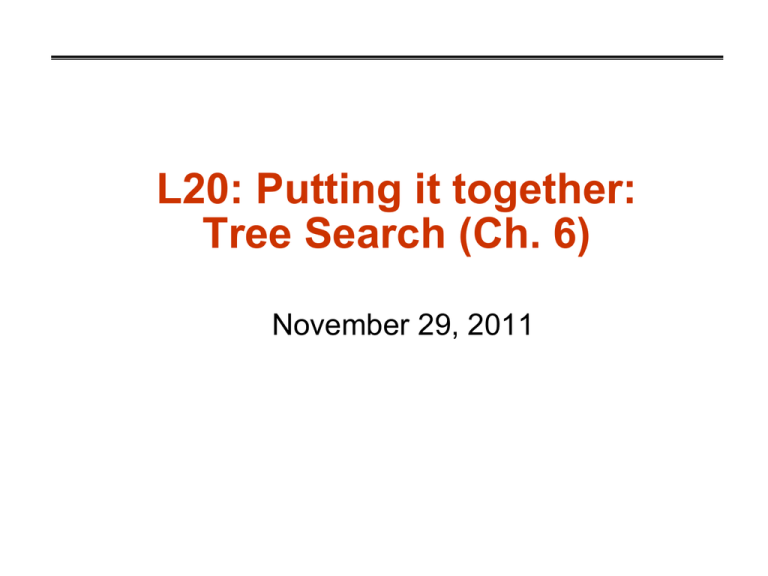
L20: Putting it together:
Tree Search (Ch. 6)
November 29, 2011
Administrative
• Next homework, CUDA, MPI (Ch. 3) and Apps (Ch. 6)
- Goal is to prepare you for final
- We’ll discuss it in class on Thursday
- Solutions due on Monday, Dec. 5 (should be straightforward
if you are in class)
• Poster dry run on Dec. 6, final presentations on Dec.
8
• Optional final report (4-6 pages) due on Dec. 14 can
be used to improve your project grade if you need
that
Outline
• Next homework
• Poster information
• SC Followup: Student Cluster Competition
• Chapter 6 shows two algorithms (N-body and Tree
Search) written in the three programming models
(OpenMP, Pthreads, MPI)
- How to approach parallelization of an entire algorithm
(Foster’s methodology is used in the book)
- What do you have to worry about that is different for each
programming model?
Homework 4, due Monday, December 5 at
11:59PM
Instructions: We’ll go over these in class on December 1. Handin
on CADE machines:
“handin cs4961 hw4 <probfile>”
1.
Given the following sequential code, sketch out two CUDA
implementations for just the kernel computation (not the host
code). Determine the memory access patterns and whether
you will need synchronization. Your two versions should (a)
use only global memory; and, (b) use both global and shared
memory. Keep in mind capacity limits for shared memory and
limits on the number of threads per block.
…
int a[1024][1024], b[1024];
for (i=0; i<1020; i++) {
for (j=0; j<1024-i; j++) {
b[i+j] += a[j][i] + a[j][i+1] + a[j][i+2] + a[j][i+3];
}
}
Homework 4, cont.
2. Programming Assignment 3.8, p. 148. Parallel merge sort
starts with n/comm_sz keys assigned to each process. It
ends with all the keys stored on process 0 in sorted order. …
when a process receives another process’ keys, it merges the
new keys into its already sorted list of keys. … parallel
mergesort … Then the processes should use tree-structured
communication to merge the global list onto process 0 , which
prints the result.
3. Exercise 6.27, p. 350. If there are many processes and many
redistributions of work in the dynamic MPI implementation of
the TSP solver, process 0 could become a bottleneck for
energy returns. Explain how one could use a spanning tree of
processes in which a child sends energy to its parent rather
than process 0.
4. Exercise 6.30, p. 350 Determine which of the APIs is
preferable for the n-body solvers and solving TSP.
a.
How much memory is required… will data fit into the memory …
b.
How much communication is required by each of the parallel algorithms
(consider remote memory accesses and coherence as communication)
c.
Can the serial programs be easily parallelized by the use of OpenMP
directives?Doe they need synchronization constructs such as condition
variables or read-write locks?
Overview
• Last time we talked about solving n-body problems.
- “Regular” computation on a grid
- Parallelization relatively straightforward through standard
data and computation partitioning
- Modest concerns about load imbalance
• This lecture on Tree Search (specifically, singlesource shortest path)
- “Irregular”
- amount of work associated with a node or path varies
- Graph may be represented by dense or sparse adjacency
matrix (sparse adjacency matrix is also irregular)
- Impact on implementation
- Load balancing? Dynamic scheduling?
- Termination
- Collecting result plus path, synchronization
Tree search problem (TSP)
• An NP-complete problem.
• No known solution to TSP that is better in all cases
than exhaustive search.
• Ex., the travelling salesperson problem, finding a
minimum cost tour.
• (Also called single-source shortest path)
Copyright © 2010, Elsevier Inc. All rights Reserved
A Four-City TSP
0 is root or single source. What is the shortest path?
Copyright © 2010, Elsevier Inc. All rights Reserved
Pseudo-code for a recursive solution to TSP
using depth-first search
Copyright © 2010, Elsevier Inc. All rights Reserved
We’ll need to eliminate recursion
• Non-recursive implementation is more flexible
• Shared data structures
• Freedom to schedule threads/processes flexibly
• How to eliminate recursion
• Explicit management of “stack” data structure
• Loop instead of recursive calls
Pseudo-code for a second solution to TSP that
doesn’t use recursion (two solutions in text)
Termination and find best solution
Can this city be added:
on path?
new to path?
shorter than existing paths?
Copyright © 2010, Elsevier Inc. All rights Reserved
Global variable – stores “best_tour”
• How to know whether global “best tour” value is
better?
• Guarantee that any writes will be performed
atomically
• Textbook suggests reading it without locking
• Value may be slightly out of date, but just
increases work slightly since value is
monotonically decreasing
• Cost of synchronizing read not worth it
• If the process’s value is not as good, not
updated
Making sure we have the “best tour”
• In the case where a thread tests and decides
it has a better global solution, we need to
ensure two things:
1) That the process locks the value with a mutex,
preventing a race condition.
2) In the possible event that the first check was
against an old value while another process was
updating, we do not put a worse value than the
new one that was being written.
• We handle this by locking, then testing again.
Copyright © 2010, Elsevier Inc. All rights Reserved
First scenario
process x
local
tour value
global
tour value
30
22
27
22
process y
local
tour value
27
3. test
1. test
6. lock
2. lock
7. test again
4. update
8. update
5. unlock
9. unlock
Copyright © 2010, Elsevier Inc. All rights Reserved
Second scenario
process x
local
tour value
global
tour value
30
27
29
process y
local
tour value
27
3. test
1. test
6. lock
2. lock
7. test again
4. update
8. unlock
5. unlock
Copyright © 2010, Elsevier Inc. All rights Reserved
Pseudo-code for a Pthreads implementation of a
statically parallelized solution to TSP
Master thread does static partitioning
using breadth-first search
Thread operates on its private stack
Needs mutex (next slides)
Copyright © 2010, Elsevier Inc. All rights Reserved
A Careful Look at Load Imbalance
• Load imbalance very likely
• The master thread is partitioning the work
• Some expensive paths will be pruned early
• What to do?
• Schedule some work statically and some
dynamically for under-utilized processors
• Minimize cost of moving work
• This could be done a lot smarter than it is
• Challenges:
• Which processes are available to take on more
work?
• When does execution terminate?
Dynamic Parallelization of Tree Search
Using Pthreads
• Termination issues.
• Code executed by a thread before it splits:
- It checks that it has at least two tours in its stack.
- It checks that there are threads waiting.
- It checks whether the new_stack variable is NULL.
Copyright © 2010, Elsevier Inc. All rights Reserved
Pseudo-Code for Pthreads Terminated Function
Do I have extra work, and are there idle threads?
Wake up an idle thread
Termination test
Copyright © 2010, Elsevier Inc. All rights Reserved
Pseudo-Code for Pthreads Terminated Function, cont.
Idle thread gets new work
Copyright © 2010, Elsevier Inc. All rights Reserved
Grouping the termination variables
Copyright © 2010, Elsevier Inc. All rights Reserved
Parallelizing the Tree Search Programs
Using OpenMP
• Same basic issues implementing the static and dynamic
parallel tree search programs as Pthreads.
• A few small changes can be noted.
Copyright © 2010, Elsevier Inc. All rights Reserved
Other OpenMP changes
• Use a critical section instead of a mutex to guard
selection of “best tour”, but similar “optimistic”
synchronization
• Need a different construct for conditional wait (not
clean)
- Next slide, but more in textbook to select particular idle
thread
- Requires auxiliary stack of idle threads to select
“awakened_thread”
OpenMP emulated condition wait
Copyright © 2010, Elsevier Inc. All rights Reserved
MPI is similar
• Static and dynamic partitioning schemes
• Maintaining “best_tour” requires global
synchronization, could be costly
- May be relaxed a little to improve efficiency
- Alternatively, some different communication constructs can
be used to make this more asynchronous and less costly
- MPI_Iprobe checks for available message rather than
actually receiving
- MPI_Bsend and other forms of send allow aggregating
results of communication asynchronously
Sending a different number of objects to
each process in the communicator to
distribute initial stack
Copyright © 2010, Elsevier Inc. All rights Reserved
Gathering a different number of objects from
each process in the communicator
Copyright © 2010, Elsevier Inc. All rights Reserved
Checking to see if a message is available
Copyright © 2010, Elsevier Inc. All rights Reserved
Terminated Function for
a Dynamically
Partitioned TSP solver
that Uses MPI.
Copyright © 2010, Elsevier Inc. All rights Reserved
Printing the best tour
Copyright © 2010, Elsevier Inc. All rights Reserved
Terminated Function for a Dynamically
Partitioned TSP solver with MPI (1)
Copyright © 2010, Elsevier Inc. All rights Reserved
Terminated Function for a Dynamically
Partitioned TSP solver with MPI (2)
Copyright © 2010, Elsevier Inc. All rights Reserved
Packing data into a buffer of contiguous
memory
Copyright © 2010, Elsevier Inc. All rights Reserved
Unpacking data from a buffer of contiguous
memory
Copyright © 2010, Elsevier Inc. All rights Reserved
Summary of Lecture
• This “tree search” is the hardest parallel
programming challenge we have studied
• Load imbalance leads to the need for dynamic scheduling,
which in turn leads to termination challenges requiring elaborate
synchronization and communication
• This may be too hard for an efficient OpenMP implementation
and is also challenging for MPI
• We did not even talk about locality!
• This chapter is dense, but getting through it is worth
it
• It shows REAL parallel programming and the need
for elaborate language constructs
• Other “irregular” algorithms are even more difficult




